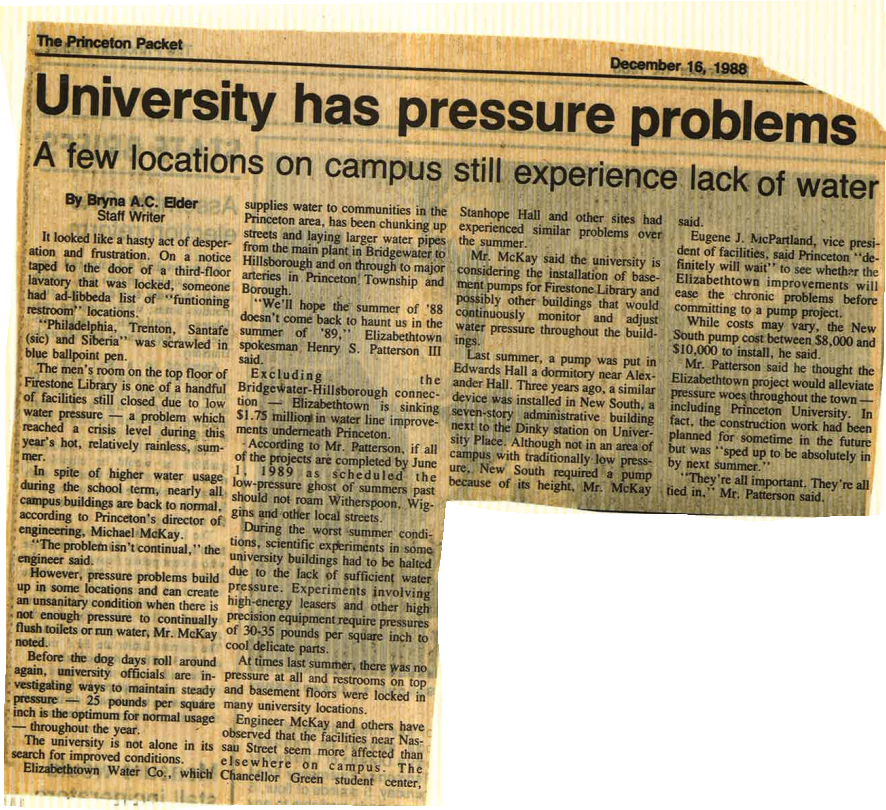 Princeton Packet
Princeton Packet
16 December, 1988
University has pressure problems
A few locations on campus still experience lack of water
By Bryna A.C. Elder
Staff Writer
It looked like a hasty act of desperation and frustration. On a notice taped to the door of a third-floor lavatory that was locked, someone had ad-libbed a list of “functioning restroom” locations.
“Philadelphia, Trenton, Santafe(sic) and Siberia” was scrawled in blue ballpoint pen.
The men’s room on the top floor of Firestone Library is one of a handful of facilities still closed due to low water pressure — a problem which reached a crisis level during this year’s hot, relatively rainless, summer.
In spite of higher water usage during the school term, nearly all campus buildings are back to normal, according to Princeton’s director of engineering, Michael McKay.
“The problem isn’t continual,” the engineer said.
However, pressure problems build up in some locations and can create an unsanitary condition when there is not enough pressure to continually flush toilets or run water, Mr. McKay noted.
Before the dog days roll around again, university officials are investigating ways to maintain steady pressure — 25 pounds per square inch is the optimum for normal usage — throughout the year.
The university is not alone in its search for improved conditions. Elizabethtown Water Co., which supplies water to communities in the Princeton area, has been chunking up streets and laying larger water pipes from the main plant in Bridgewater to Hillsborough and on through to major arteries in Princeton Township and Borough.
“We’ll hope the summer of ’88 doesn’t come back to haunt us in the summer of ’89,” Elizabethtown spokesman Henry S. Patterson III said.
Excluding the Bridgewater-Hillsborough connection — Elizabethtown is sinking $1.75 million in water line improvement underneath Princeton.
According to Mr. Patterson, if all of the projects are completed by June 1, 1989 as scheduled the low-pressure ghost of summers past should not roam Witherspoon. Wiggins and other local streets.
During the worst summer conditions, scientific experiments in some university buildings had to be halted due to the lack of sufficient water pressure. Experiments involving high-energy leasers and other precision equipment require pressures of 30-35 pounds per square inch to cool delicate parts.
At times last summer, there was no pressure at all and restrooms on top and basement floors were locked in many university locations.
Engineer McKay and others have observed that the facilities near Nassau Street seem more affected than elsewhere on campus. The Chancellor Green student center, Stanhope Hall and other sites had experienced similar problems over the summer.
Mr. McKay said the university is considering the installation of basement pumps for Firestone Library and possibly other buildings that would continuously monitor and adjust water pressure throughout the buildings.
Last summer, a pump was put in Edwards Hall a dormitory near Alexander Hall. Three years ago, a similar device was installed in New South, a seven-story administrative building next to the Dinky station on University Place. Although not in an area of campus with traditionally low pressure, New South required a pump because of its height, Mr. McKay said.
Eugene J. McPartland, vice president of facilities, said Princeton “definitely will wait” to see whether the Elizabethtown improvements will ease the chronic problems before committing to a pump project.
While costs may vary, the New South pump cost between $8,000 and $10,000 to install, he said.
Mr.Patterson said he thought the Elizabethtown project would alleviate pressure woes throughout the town — including Princeton University. In fact, the construction work had been planned for sometime in the future but was “sped up to be absolutely in by next summer.”
“They’re all important. They’re all tied in.” Mr.Patterson said.